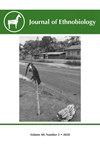半驯化作物在农业生态系统中的独特功能作用:哥伦比亚安第斯山脉多年生豆类(Phaseolus dumosus和P. coccineus)和景观民族生态学
IF 1.3
3区 社会学
Q1 ANTHROPOLOGY
引用次数: 3
摘要
摘要半驯化植物是农业生态学的良好资源,因为它们可以在没有人为干预的情况下生存,并且可以与非驯化植物一起管理。为了探索农民在景观层面管理半驯化作物的生态知识,我们比较了哥伦比亚安第斯山脉西南部的亚纳科纳土著人如何管理两种半驯化的菜豆,这两种菜豆都是当地命名的仙人掌(菜豆和豆豆豆)和一种完全驯化的作物(普通菜豆菜豆)。我们调查了农民识别出的菜豆功能特征,以及农民如何将这些特征与菜豆在景观中不同文化生态位中发育的能力联系起来。在对Yanacona农民进行的60次半结构化访谈中,我们发现(i)农民比较了不同豆类物种的功能特征,包括多年生性、酚性、对病虫害的抵抗力以及与周围植被竞争的能力;(ii)农民认识到并利用两种可可品种杂交产生的变异;(iii)农民利用可可豆的特性,在景观范围内的广泛生态位下种植可可豆,包括低干预空间,如树篱和休耕的沼泽地,并详细了解可可豆与树木的相互作用;以及(iv)可可特性通过与之相关的管理实践和社会关系,有助于农业生态系统的恢复力。为了充分理解栽培植物功能性状的作用,必须将Emic和etic的观点结合起来。本文章由计算机程序翻译,如有差异,请以英文原文为准。
Semi-Domesticated Crops Have Unique Functional Roles in Agroecosystems: Perennial Beans (Phaseolus dumosus and P. coccineus) and Landscape Ethnoecology in the Colombian Andes
Abstract. Semi-domesticated plants are good resources for agroecology, because they can survive without human intervention and can be managed together with non-domesticated plants. To explore the ecological know-how underlying farmer management of semi-domesticates at the landscape level, we compared how Yanacona Indigenous People in the southwestern Colombian Andes manage two semi-domesticated species of Phaseolus beans, both locally named cacha (Phaseolus coccineus and P. dumosus), and a full domesticate (the common bean Phaseolus vulgaris). We investigated what functional traits of Phaseolus beans farmers identify and how farmers link these traits with the ability of beans to develop in different cultural-ecological niches within the landscape. In 60 semi-structured interviews conducted with Yanacona farmers, we found that (i) farmers compare functional traits of the different bean species, including perenniality, phenology, resistance to pests and diseases, and ability to compete with surrounding vegetation; (ii) farmers recognize and use the variation generated by hybridization between the two cacha species; (iii) farmers take advantage of the traits of cacha to grow them under a wide array of niches at the landscape scale, including low-intervention spaces, such as hedges and swidden plots in fallow, and have detailed knowledge of cacha beans' interactions with trees; and (iv) cacha traits contribute to the resilience of agroecosystems through the management practices and social relationships with which they are associated. Emic and etic perspectives must be combined to gain full understanding of the roles of functional traits of cultivated plants.
求助全文
通过发布文献求助,成功后即可免费获取论文全文。
去求助
来源期刊

Journal of Ethnobiology
Social Sciences-Anthropology
CiteScore
4.80
自引率
3.40%
发文量
21
审稿时长
>12 weeks
期刊介绍:
JoE’s readership is as wide and diverse as ethnobiology itself, with readers spanning from both the natural and social sciences. Not surprisingly, a glance at the papers published in the Journal reveals the depth and breadth of topics, extending from studies in archaeology and the origins of agriculture, to folk classification systems, to food composition, plants, birds, mammals, fungi and everything in between.
Research areas published in JoE include but are not limited to neo- and paleo-ethnobiology, zooarchaeology, ethnobotany, ethnozoology, ethnopharmacology, ethnoecology, linguistic ethnobiology, human paleoecology, and many other related fields of study within anthropology and biology, such as taxonomy, conservation biology, ethnography, political ecology, and cognitive and cultural anthropology.
JoE does not limit itself to a single perspective, approach or discipline, but seeks to represent the full spectrum and wide diversity of the field of ethnobiology, including cognitive, symbolic, linguistic, ecological, and economic aspects of human interactions with our living world. Articles that significantly advance ethnobiological theory and/or methodology are particularly welcome, as well as studies bridging across disciplines and knowledge systems. JoE does not publish uncontextualized data such as species lists; appropriate submissions must elaborate on the ethnobiological context of findings.
 求助内容:
求助内容: 应助结果提醒方式:
应助结果提醒方式:


